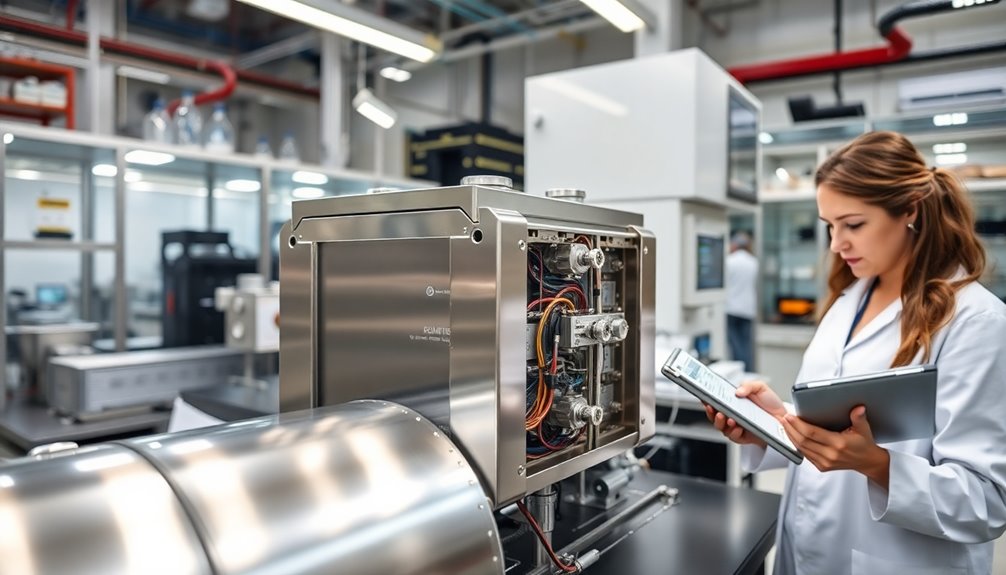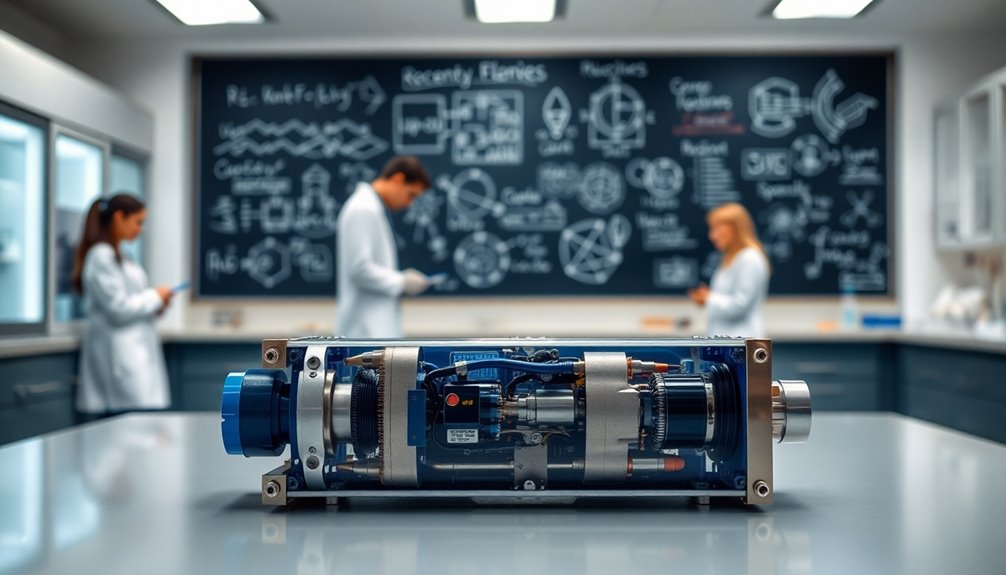Unitized Regenerative Fuel Cells (URFCs) are innovative devices that work as both electrolyzers and fuel cells, converting water into hydrogen and generating electricity. However, they face core challenges like water management, durability of materials, and limited electrode efficiency. Recent advancements include improved membrane technology and novel designs that enhance performance. These developments promise increased efficiency and broader adoption in renewable energy applications. Keep exploring to uncover more about their potential impact on the energy landscape.
Key Takeaways
- URFCs face core challenges such as water management, material durability, and electrode efficiency during mode transitions.
- Recent advancements include novel designs with hydrophilic and hydrophobic properties that enhance operational efficiency.
- Innovations in membranes and electrodes have improved the durability and longevity of URFCs under high-stress conditions.
- Integrated system designs have reduced component count, making URFCs more compact and cost-effective for energy solutions.
- Ongoing research and collaboration are driving advancements towards commercial scalability and wider adoption of URFC technology.

As renewable energy sources gain traction, Unitized Regenerative Fuel Cells (URFCs) emerge as a promising solution for efficient energy storage and generation. These innovative devices operate in both electrolysis and fuel cell modes, allowing them to convert water into hydrogen and oxygen while also generating electricity by recombining those elements. With their compact hardware design, URFCs offer an eco-friendly alternative that suits a variety of applications, from aerial and space missions to remote power systems.
However, you'll encounter core challenges that hinder their widespread adoption. One significant issue is water management, where maintaining optimal water flow during mode transitions can impact overall efficiency. Additionally, the materials and structures used in URFCs must endure the rigors of both operational modes without degrading, which raises concerns about durability. You'll also need to consider the electrode efficiency, as the transport of water and gases can limit performance unless optimized surfaces are developed. The 1,700 charge-discharge cycles achieved with minimal degradation at high current densities highlight the potential for improving these challenges.
Core challenges such as water management and material durability must be addressed for URFCs to achieve widespread adoption.
Despite these challenges, recent advancements are paving the way for improved URFC technology. Novel designs featuring hydrophilic and hydrophobic properties in electrodes have significantly enhanced efficiency. Material innovations in membranes and electrodes are also contributing to better durability, while integrated system designs simplify the overall structure, reducing both component count and space requirements. Such improvements make URFCs effective energy storage devices, particularly in remote areas where renewable energy systems thrive.
Furthermore, ongoing research collaborations are accelerating the development of URFC technology, driving us closer to commercial scalability. The dual capability of URFCs to function as both electrolyzers and fuel cells within a single unit sets them apart from traditional systems, offering a compact and cost-effective solution.
As you explore the potential of URFCs, you'll recognize their vital role in the future of energy storage and generation, contributing to a more sustainable and efficient energy landscape.
Frequently Asked Questions
What Are the Environmental Benefits of Using Unitized Regenerative Fuel Cells?
Using unitized regenerative fuel cells (URFCs) offers significant environmental benefits.
You'll reduce carbon emissions by converting excess renewable energy into hydrogen, supporting a low-carbon economy.
URFCs replace fossil fuels, cutting air pollution and noise, creating a quieter environment.
They also enhance energy independence by storing renewable energy, minimizing reliance on external fuel sources.
Plus, URFCs protect sensitive ecosystems, making them a sustainable choice for energy production and environmental preservation.
How Do Unitized Regenerative Fuel Cells Compare to Traditional Batteries?
When you compare unitized regenerative fuel cells (URFCs) to traditional batteries, you'll notice key differences.
URFCs store energy externally as hydrogen and oxygen, while batteries store it internally. URFCs offer better scalability, allowing you to adjust energy storage without affecting power output.
They're also more durable, avoiding degradation from deep cycling. Plus, URFCs produce no pollution, making them environmentally friendly, whereas some batteries can contain hazardous materials.
What Industries Are Most Likely to Adopt Unitized Regenerative Fuel Cells?
Imagine a future where electric vehicles use unitized regenerative fuel cells (URFCs) to seamlessly switch between charging and driving modes.
Industries like aerospace, energy, and transportation are likely to adopt URFCs due to their high energy density and cost efficiency.
Aerospace applications benefit from lightweight designs, while renewable energy systems enhance solar power integration.
As these sectors seek sustainable solutions, URFCs could revolutionize energy management across various platforms.
What Safety Concerns Are Associated With Unitized Regenerative Fuel Cells?
When working with unitized regenerative fuel cells, you've got to be aware of several safety concerns.
Hydrogen storage risks include flammability and potential leaks, while handling oxygen can be hazardous in confined spaces.
The risk of combustible gas mixtures and thermal control challenges also demand attention.
Component failures can lead to uncontrolled releases, and mode-switching hazards may compromise system stability.
Always prioritize safety protocols and training for personnel involved in operations.
What Is the Future Outlook for Unitized Regenerative Fuel Cell Technology?
Unitized regenerative fuel cell technology could potentially increase hydrogen generation efficiency by two-fold compared to traditional methods, making it a game-changer.
As you look to the future, expect advancements in materials science to drive more efficient components. Their high energy density makes them ideal for aerospace applications and grid-scale energy storage.
With ongoing research and collaboration, you can anticipate URFCs playing a crucial role in sustainable energy solutions and carbon neutrality efforts.
Conclusion
In summary, unitized regenerative fuel cells hold immense promise for sustainable energy, but they face significant challenges that need addressing. For instance, studies show that improving efficiency by just 10% could reduce overall energy costs by nearly 20%. This realization highlights the critical need for ongoing research and innovation. By tackling these core challenges, we can unlock the full potential of these cells and make a substantial impact on the future of clean energy.









